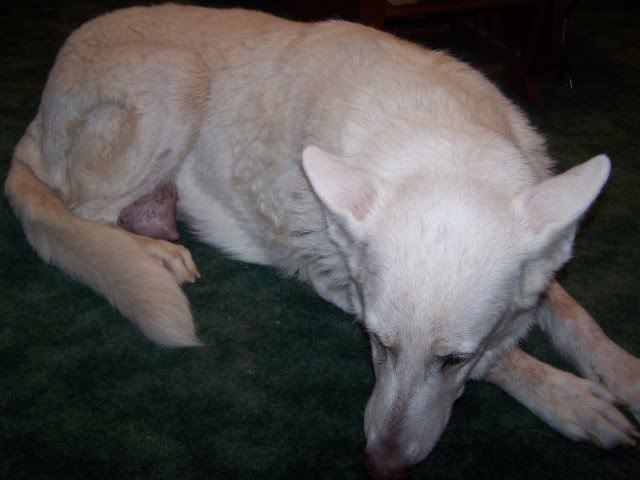Nag, nag, nag. We're like those scary public health commercials in this blog. It's just that every time we do some research to add to the blog, we find scary stuff. Of course, we find scary stuff when we're looking for recipes, too.
But heartworm disease can really hurt dogs; and we see so many dogs in rescue who are heartworm positive (because we test them - if we didn't test we wouldn't know we have HW+ dogs). Then on top of the heartworm disease, they are not in good shape otherwise.
Cheyenne with Southern Cross German Shepherd Rescue was one such case. We can't remember if she had a tick disease or not, but if she didn't, it was probably because the ticks wanted a healthier subject! She was heartworm positive, stage 3, had a mammary tumor, staph, flea dermatitis, bad hips, chronic ear infections, was in heart failure, exercise intolerant. She did not respond well to the first shot of Immiticide to kill the adult worms, so only had the one shot and then went to the slow kill treatment method.
Because she had a rescue that backed her and a foster family who was willing and gifted in taking care of every need, in a planned systematic way, Cheyenne is now a healthy happy senior girl. So now that we've had a happy moment, back to the scary. And some of this is things we have already learned a bit about, but with a creepier, scarier twist. It's Halloween in August!
 |
| And same dog - after |
Symptoms
(Again with this crazy foot long worm info - yes!) Adult heartworms can reach 12 inches in length and can remain in the dog’s heart for several years.
Dogs can have some microfilariae (baby worms) in their blood and worms in their lungs without manifesting (to show plainly or clearly - why do these websites always make us go to the dictionary?) the disease. Once the number of worms exceeds a certain number based on the size and activity level of the dog, however, the adult worms move to the heart and symptoms begin to occur. Very active dogs may experience symptoms with lower numbers of worms than couch-potato dogs. (Interesting and kind of scary since so many dogs like the couch so does that mean they are actually sicker longer before we know it? We need an on call vet service for neurotics with questions!)
The time lag between the initial infestation of microfilariae (baby worms) and reproduction by adult worms living in the heart is six-to-seven months in dogs. (That we knew - and is why we heartworm test dogs twice after they have not been using medicines for a long period of time, once in the beginning and then six-seven months later.)
Female heartworms bear live young – thousands of them in a day. (Again - scary - thousands of baby worms a day.) The babies circulate in the bloodstream for as long as three years, waiting to hitch a ride in a bloodsucking mosquito. (Good heavens - three years - that's super scary!) They undergo changes in the mosquito that prepare them to infect a dog, and they transfer back to the original host species the next time the mosquito bites. The process of change in the mosquito takes about 10 days in warm climates, but can take six weeks in colder temperatures. (Oh my gosh - freaky, scary Christoph Waltz mutating mosquitoes.)
The worms grow and multiply, infesting the chambers on the right side of the heart and the arteries in the lungs. They can also lodge in the veins of the liver and the veins entering the heart. (Not cool, man, not cool.)
The first sign of heartworm infestation may not manifest for a year after infection (doing damage all the time), and even then the EARLY SYMPTOM ALERT: soft cough that increases with exercise may be dismissed as unimportant by the owner.
More:
The cough worsens
The dog may actually faint from exertion
They tire easily
They are weak and listless,
Those lose weight and condition
They may cough up blood.
Breathing becomes more difficult as the disease progresses.
The progression is traumatic: the dog’s quality of life diminishes drastically and he can no longer retrieve a Frisbee (FRISBEE?!? Are you kidding me! Watch the knees and ligaments there, people!) or take a long walk in the park without respiratory distress. Congestive heart failure ensues, and the once-active, outgoing pet is in grave danger.
EDIT - just found this and liked the way it explained things http://www.petplace.com/dogs/heartworm-disease-in-dogs/page1.aspx:
EDIT - just found this and liked the way it explained things http://www.petplace.com/dogs/heartworm-disease-in-dogs/page1.aspx:
Symptoms don't usually develop until damage has already occurred to the heart. Dogs can have a wide range of symptoms, with some dogs being completely asymptomatic (no symptoms at all). Symptoms usually occur because of heart failure. These include:
Coughing
Coughing up of blood (hemoptysis)
Heavy breathing
Unwillingness to exercise
Signs of right sided congestive heart failure, which include fluid distention of the belly, pulsation of the jugular veins in the neck when the dog is sitting or standing and heavy breathing.
After all this scary stuff, take a few deep breaths and realize that all you need to do to prevent this is:
Test yearly
Use heartworm medication year round
And that works almost 100% of the time (let's not go there).
But by knowing this, you can help the dogs of your friends, family, neighbors and co-workers. And if you ever volunteer for a rescue (please, we all love volunteers), you will be able to contribute your knowledge right away.
Next time: Mila talks about treatment restrictions and then the treatment protocols

Thanks for all the info. I have a foster dog who came out of the shelter last Friday HW+. He's already got the cough, murmur, and heat intolerance. We've started doxy, Heartgard, and prednisone and just hoping there's Immiticide back in stock by the time he gets that shot in 30 days. I've done a bunch of research, but really appreciate the way you broke down the treatment plan with photos, updates, etc. Makes it a bit less scary, if that makes sense.
ReplyDeleteThank you - we are glad that it's helping. Did they do the x-rays? That poor dog. It is a scary thing but if the information we can give makes it less so, that's good. The Immiticide thing is *not* good. Definitely let us know how he's doing.
ReplyDeletePosted some links about the Immiticide unavailability.
ReplyDeleteThey didn't do xrays, rescue wouldn't cover the cost. So we opted to treat based on presumed pulmonary inflammation. Started him on doxy & prednisone. Vet called Tuesday to say they had immiticide (yay) and needed to use it in conjunction with another dog, so he got his first shot today. Comes home in the morning. So glad you mentioned the need for pain meds, we'll get those for him for sure. And hopefully it will be easy to keep a 4 year old Rat Terrier quiet in a housefull of Border Collies & another Rattie. Right? :-)
ReplyDeleteHow is it going!
ReplyDeleteI am really happy that i have been cured from (HERPES SIMPLEX VIRUS) with
ReplyDeletethe herbal medicine of dr.chala, i have been suffering from this disease
for the past 2 years and 7 mouth without solution until i came across the
blog of this doctor who have cure so many people with his herbal medicine,
i also choose to give him a chance to help me 👍, he told me what
to do and i kindly did it, and he gave us his herbal medicine and direct me
on how to use it, i also follow his instructions for use and he ask us to
go for a check up after a week and some days which i did, to my greatest
surprise our result came out as negative, and ever since then, we have had
no more outbreak and we are healthy, we are really happy that there is
someone like this doctor who is ready to help anytime any day. he also
render cure to the following diseases below
.DIABETES
.CANCER
.HEPATITIS
.HIV/AIDS
.P COS4 contact him via what's app +2348165102815 or email dr.chalaherbalhome@gmail.com